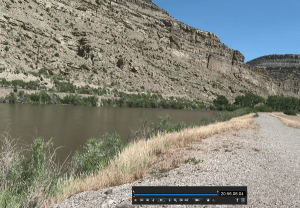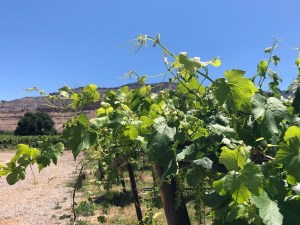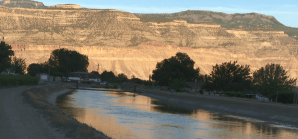PALISADE, Colo. (KDVR) — Clusters of green grapes cover rows of vines at Sauvage Spectrum winery on the Western Slope in Mesa County. While the grape vines are green and healthy, the ground surrounding the vineyard is parched and the soil crumbles into dust due to years of prolonged drought.
Grape grower Kaibab Sauvage moves through his vineyard trimming excess leaves off the vines since more leaves use more water.
“We’re going to come through and do cluster counts per vine,” Sauvage said. “This year, we plan to take in 80 tons of fruit, which should produce about 5,000 cases of wine.
Maze of irrigation
Since agriculture consumes more water than any other industry in Colorado, shrinking river flows, low precipitation and hot temperatures are forcing farmers in western Colorado to constantly calculate their watering plan.
“It’s phenomenal how much we depend on water here,” explained Sauvage who has worked the land for 22 years.
The dusty slopes prove the region’s annual rainfall of about 10 inches leaves farmers relying on irrigation ditches, like the Price and Stub ditches, to move water from the Colorado River to their crops.
“When we first started, we flood irrigated the vineyards because that is traditionally how irrigation was done on peaches over the years,” said Sauvage.
Those days are long gone with micro sprinkler systems using less water and moisture meters monitoring how deep the irrigation goes.
“If we can save a little time and stretch those irrigation schedules,” said Sauvage. “We are also planting drought-resistant cover crops.”
Grapes use less water than peaches and hay fields, but grape farmers told FOX31, they are doing what they can to limit water use during cultivation and winemaking.“
“Water is expensive, especially in Palisade,” said Rainer Thoma who runs Grande River Vineyards at Wine Country Inn.
Thoma went to a low till system at the 21-acre vineyard to help keep water in the soil.
“It will keep the water that’s in the ground from evaporating which also helps from erosion,” said Thoma who brought his 20-plus years of tending vines and making wine from Germany to the Western Slope.
Tourism
Tourism is one of the largest industries in the state welcoming 86 million visitors in 2019.
Thoma believes conservation on the Colorado River is key to the tourism that supports the Western Slope and said their sales depend on tourists.
“Tourism is our main source of revenue,” said Thoma. “They do come to see the vineyards. They do come to ride around in the wine country. They do come to eat peaches and the fresh produce we produce in the valley.”
As the grapes develop through the heat of the summer, they will need less water as they ripen and are harvested come fall.

“You can’t make good wine from bad grapes, that’s what it comes down to,” Sauvage said. “We all need to do our part and conserve water and hope for the best.”
In terms of consumptive use, agricultural water use accounts for 89% of the statewide total use. According to state data, the number of irrigated acres is expected to decline by 15-20% by 2050 due in part to urbanization.
The Grand Valley, which runs along the Colorado River in Mesa County, is named after the Grand River, the historical name of the Colorado River.
For more coverage of this story, visit our Colorado River Crisis coverage page.





